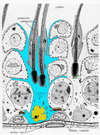Local signalling environments and human male infertility: what we can learn from mouse models
- PMID: 20456819
- PMCID: PMC3056269
- DOI: 10.1017/S1462399410001468
Local signalling environments and human male infertility: what we can learn from mouse models
Abstract
Infertility is one of the most prevalent public health problems facing young adult males in today's society. A clear, treatable cause of infertility cannot be determined in a large number of these patients, and a growing body of evidence suggests that infertility in many of these men may be due to genetic causes. Studies using mouse knockout technology have been integral for examination of normal spermatogenesis and to identify proteins essential for this process, which in turn are candidate genes for human male infertility. Successful spermatogenesis depends on a delicate balance of local signalling factors, and this review focuses on the genes that encode these factors. Normal functioning of all testicular cell types is essential for fertility and might also be crucial to prevent germ cell oncogenesis. Analysis of these signalling processes in spermatogenesis using mouse models has provided investigators with an invaluable tool to effectively translate basic science research to the research of human disease and infertility.
References
-
- Russell LD, Griswold MD. The Sertoli cell. 1st, eds. Clearwater, FL: Cache River Press; 1993.
-
- Skinner MK, Griswold MD. Sertoli cell biology. Boston: Elsevier Academic Press, Amsterdam; 2005.
-
- Russell LD. Histological and histopathological evaluation of the testis. 1st, eds. Clearwater, Fl: Cache River Press; 1990.
-
- Yoshida S, Sukeno M, Nabeshima Y. A vasculature-associated niche for undifferentiated spermatogonia in the mouse testis. Science. 2007;317:1722–1726. - PubMed
Publication types
MeSH terms
Grants and funding
LinkOut - more resources
Full Text Sources
Medical



